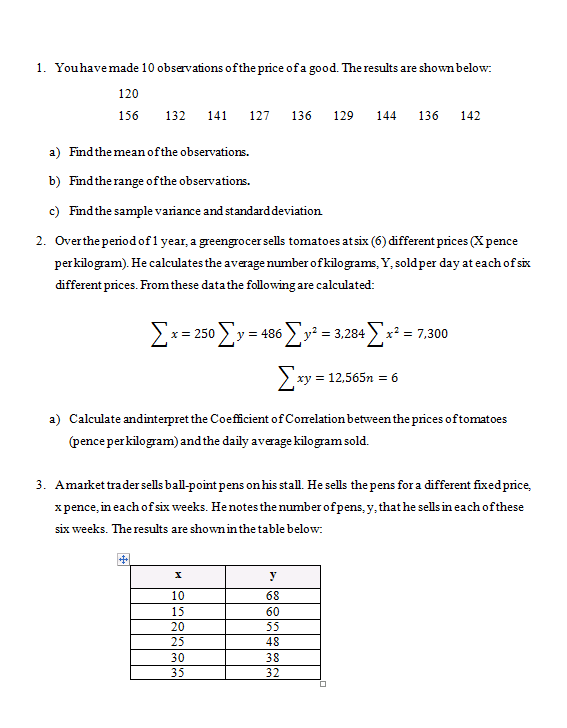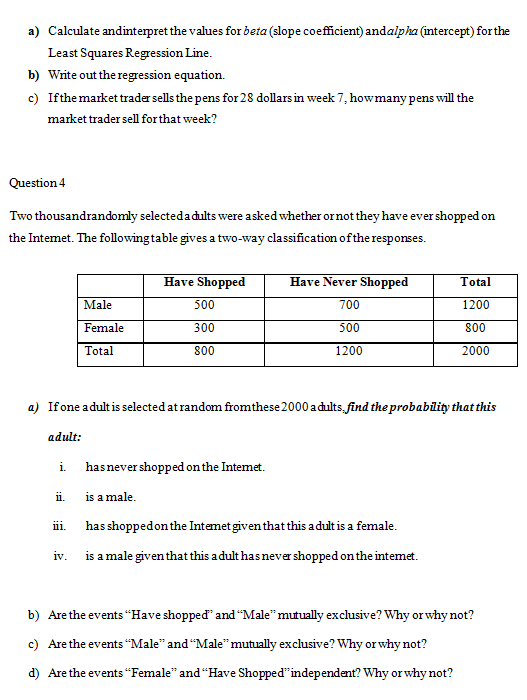1. You have made 10 observations of the price of a good. The results are shown below: 120 156 132 141 127 136 129 144 136 142 a) Find the mean of the observations. b) Find the range of the observations. c) Find the sample variance and standard deviation
1. You have made 10 observations of the price of a good. The results are shown below: 120 156 132 141 127 136 129 144 136 142 a) Find the mean of the observations. b) Find the range of the observations. c) Find the sample variance and standard deviation
Glencoe Algebra 1, Student Edition, 9780079039897, 0079039898, 2018
18th Edition
ISBN:9780079039897
Author:Carter
Publisher:Carter
Chapter10: Statistics
Section10.4: Distributions Of Data
Problem 19PFA
Related questions
Question

Transcribed Image Text:1. You have made 10 observations of the price of a good. The results are shown below:
120
156
132 141 127 136 129 144 136 142
a) Find the mean of the observations.
b) Find the range of the observations.
c) Find the sample variance and standard deviation
2. Over the period of 1 year, a greengrocer sells tomatoes at six (6) different prices (X pence
per kilogram). He calculates the average number of kilograms, Y, sold per day at each of six
different prices. From these data the following are calculated:
Σχ = 250 Σy =
y = 486
36 Σy¹² = 3,284 [x²
x² = 7,300
Σ
xy = 12,565n = 6
a) Calculate and interpret the Coefficient of Correlation between the prices of tomatoes
(pence per kilogram) and the daily average kilogram sold.
3. Amarket trader sells ball-point pens on his stall. He sells the pens for a different fixed price,
x pence, in each of six weeks. He notes the number of pens, y, that he sells in each of these
six weeks. The results are shown in the table below:
y
10
68
15
60
20
55
25
48
30
38
35
32
900 00
D

Transcribed Image Text:a) Calculate and interpret the values for beta (slope coefficient) and alpha (intercept) for the
Least Squares Regression Line.
b) Write out the regression equation.
c) If the market trader sells the pens for 28 dollars in week 7, how many pens will the
market trader sell for that week?
Question 4
Two thousandrandomly selected adults were asked whether or not they have ever shopped on
the Internet. The following table gives a two-way classification of the responses.
Have Shopped
Have Never Shopped
Total
Male
500
700
1200
Female
300
500
800
Total
800
1200
2000
a) If one adult is selected at random from these 2000 adults, find the probability that this
adult:
i.
has never shopped on the Internet.
ii.
is a male.
111.
has shopped on the Internet given that this adult is a female.
iv.
is a male given that this adult has never shopped on the internet.
b) Are the events "Have shopped" and "Male" mutually exclusive? Why or why not?
c) Are the events Male" and "Male" mutually exclusive? Why or why not?
d) Are the events "Female" and "Have Shopped" independent? Why or why not?
Expert Solution
This question has been solved!
Explore an expertly crafted, step-by-step solution for a thorough understanding of key concepts.
Step by step
Solved in 4 steps with 9 images

Follow-up Questions
Read through expert solutions to related follow-up questions below.
Follow-up Question
Two thousand randomly selected adults were asked whether or not they have ever shopped on the Internet. The following table gives a two-way classification of the responses.
|
|
Have Shopped |
Have Never Shopped |
Total |
|
Male |
500 |
700 |
1200 |
|
Female |
300 |
500 |
800 |
|
Total |
800 |
1200 |
2000 |
a) If one adult is selected at random from these 2000 adults, find the probability that this adult
- has never shopped on the Internet =
- is a male =
- has shopped on the Internet given that this adult is a female =
- is a male given that this adult has never shopped on the internet =
B) . Are the events “Have shopped” and “Male” mutually exclusive? Why or why not?
C) Are the events “Male” and “Male” mutually exclusive? Why or why not?
D) Are the events “Female” and “Have Shopped” independent? Why or why not?
Solution
Recommended textbooks for you

Glencoe Algebra 1, Student Edition, 9780079039897…
Algebra
ISBN:
9780079039897
Author:
Carter
Publisher:
McGraw Hill

Glencoe Algebra 1, Student Edition, 9780079039897…
Algebra
ISBN:
9780079039897
Author:
Carter
Publisher:
McGraw Hill